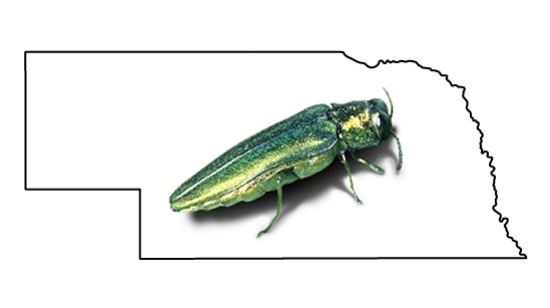In mid-June, the City of Denver confirmed the presence of the emerald ash borer (EAB)…

Emerald ash borer discovered in Lincoln, Neb.
LINCOLN, Neb. — Emerald ash borer (EAB) was first found in Nebraska in June 2016, but it has now been discovered in Lincoln, the state’s second largest city. The news was confirmed by the Nebraska Department of Agriculture (NDA) in partnership with the U.S. Department of Agriculture (USDA) on Aug. 22.
Previously, the NDA had confirmed infestations in Cass and Douglas counties. Douglas County is where Omaha, Nebraska’s largest city, is located. In addition to the discovery in Lincoln, the NDA also reported signs of an infested tree in the smaller town of Fremont, which is approximately 50 miles north of Lincoln.
“While it’s unfortunate we found EAB in Lincoln and signs of an infested tree in Fremont, it is not unexpected considering we have confirmed EAB infestations in Douglas and Cass counties,” NDA Director Steve Wellman said.
The Nebraska counties of Douglas, Sarpy, Cass, Washington and Dodge remain under a quarantine order that was issued after the initial discovery of EAB in 2016, which includes prohibiting ash nursery stock from leaving the quarantine area and regulating the movement of hardwood firewood and mulch, ash timber products and green waste material out of quarantined areas. Quarantines are put in place to reduce the human-assisted spread of EAB into non-infested areas.
An invasive pest, EAB has killed hundreds of millions of ash trees in more than 30 states and parts of Canada. The first Colorado discovery of the pest was recorded in Boulder in 2013. Since then, EAB has also been discovered in Longmont, Lafayette, Lyons, Superior and Gunbarrel.
While EAB has not yet been discovered in Denver, similar to Lincoln, Neb., it’s only a matter of time before it arrives. And when it does, it will pose an immediate threat to 330,000 ash trees in Denver and 1.45 million ash trees in the Metro area. But who wants to be a Debbie Downer when you can Be A Smart Ash? Below are some tips and tricks offered right here on this very website for residents in and around Denver worried about whether they may have an ash tree.
EAB tips for Denver & Front Range Residents:
- Determine now if you have any ash trees: Identifying features of ash trees include compound leaves with 5 to 9 leaflets; leaflets, buds and branches growing directly opposite from one another; and diamond-shaped bark ridges on mature trees. Denver residents can also visit the Be A Smart Ash interactive map to see if they have an ash tree on or around their property. You can also help Denver map its urban canopy population by tagging your own tree on the Curio app.
- If you have an ash tree, start planning: Decide if the overall health of the tree merits current or future treatment or if it would be best to remove and replace it with a different species. If you aren’t sure, contact a certified arborist. Denver residents can find a list of Smart Ash Certified tree treatment professionals specially equipped to administer EAB treatment plans. If you’re interested in exploring your treatment options, spend some time with The Smart Ash! He’s our very own arborist superhero teaching Denver residents how to fight EAB through four specific treatment methods.
- Recognize signs of EAB infestation: Property owners with ash trees should be on the lookout for thinning of leaves in the upper tree canopy, 1/8-inch D-shaped holes on the bark and vertical bark splitting with winding S-shaped tunnels underneath. Report suspect trees by calling the Denver City Forester’s office at 720-913-0651 or by filling out this EAB Report Form.
- Be aware of EAB imposters: Other insects like lilac/ash borer, ash bark beetle and flat-headed apple tree borer may look like EAB or cause similar tree symptoms.
- Help prevent further spread of EAB: Do not transport ash or any hardwood firewood, or any other untreated ash wood products, to other locations. Boulder County and some surrounding areas are under an EAB quarantine, which may mean fines for those who move untreated wood from the area.
